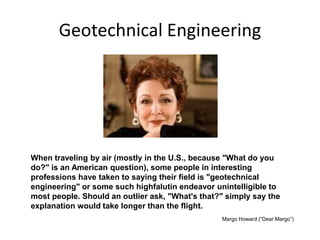The Main Principles Of Geotheta
The Main Principles Of Geotheta
Blog Article
Getting My Geotheta To Work
Table of ContentsGeotheta Things To Know Before You Buy9 Easy Facts About Geotheta ShownNot known Facts About GeothetaThe Ultimate Guide To GeothetaThe Best Guide To Geotheta

They carry out website investigations, collect samples, execute laboratory tests, and examine data to review the viability of the ground for construction jobs - Geo Tech Engineering. Based upon their searchings for, geotechnical designers provide suggestions for foundation layout, slope stability, maintaining frameworks, and mitigation of geotechnical dangers. They team up with other professionals, such as designers, structural designers, and construction groups, to make certain that geotechnical factors to consider are incorporated right into the general task design and implementation
By analyzing the actions and buildings of soil and rock, they can identify potential geotechnical threats such as landslides, soil settlement, or slope instability. Their experience helps prevent failings or mishaps that might endanger lives and building. Below are some detailed duties and obligations of a geotechnical engineer: Site Investigation: Geotechnical designers conduct website investigations to gather information on subsurface problems.
They translate the information to recognize the homes and actions of the dirt and rock, including their toughness, permeability, compaction characteristics, and groundwater conditions. Geotechnical Evaluation and Design: Geotechnical engineers analyze the data gathered during site investigations to evaluate the stability and suitability of the website for construction projects. They perform geotechnical estimations and modeling to review aspects such as bearing capacity, negotiation, slope security, side earth stress, and groundwater circulation.
The Main Principles Of Geotheta
Structure Design: Geotechnical engineers play a vital role in designing foundations that can securely support the designated framework. They analyze the soil conditions and tons requirements to identify the appropriate foundation type, such as shallow structures (e.g., grounds), deep foundations (e.g (https://geotheta.webflow.io/)., heaps), or specialized strategies like soil enhancement. They think about variables such as settlement limits, birthing ability, and soil-structure communication to establish optimum structure styles
They review building plans, screen website tasks, and carry out field inspections to confirm that the design referrals are complied with. If unpredicted geotechnical concerns occur, they assess the circumstance and give recommendations for removal or adjustments to the style. Risk Assessment and Mitigation: Geotechnical designers assess geotechnical threats and dangers related to the task website, such as landslides, liquefaction, or soil erosion.

Partnership and Interaction: Geotechnical engineers function closely with various other specialists included in a job, such as engineers, structural designers, and building and construction teams. Efficient communication and cooperation are necessary to incorporate geotechnical considerations right into the overall task design and building procedure. Geotechnical engineers supply technological expertise, response queries, and make sure that geotechnical needs are met.
The Facts About Geotheta Revealed
Below are some kinds of geotechnical designers: Foundation Designer: Structure designers concentrate on making and assessing foundations for structures. They assess the soil conditions, load needs, and site attributes to figure out the most appropriate structure kind and layout, such as shallow foundations, deep foundations, or specialized strategies like pile structures.
They assess the elements influencing slope stability, such as dirt buildings, groundwater conditions, and slope geometry, and create approaches to stop slope failures and mitigate dangers. Earthquake Engineer: Quake engineers specialize in analyzing and creating frameworks to endure seismic pressures. They examine the seismic risk of a site, assess dirt liquefaction potential, and establish seismic style criteria to make sure the security and strength of frameworks during earthquakes.
They perform area screening, gather examples, and evaluate the accumulated information to define the dirt residential or commercial properties, geologic developments, and groundwater problems at a site. Geotechnical Instrumentation Designer: Geotechnical instrumentation engineers concentrate on surveillance and determining the behavior of dirt, rock, and frameworks. They install and keep instrumentation systems that check factors such as dirt settlement, groundwater degrees, slope activities, and structural displacements to analyze efficiency and provide early warnings of prospective problems.
The Ultimate Guide To Geotheta
They perform examinations such as triaxial tests, combination examinations, direct shear examinations, and leaks in the structure tests to gather data for geotechnical analysis and layout. Geosynthetics Engineer: Geosynthetics engineers concentrate on the design and application of geosynthetic products, such as geotextiles, geogrids, and geomembranes. They utilize these materials to enhance dirt security, reinforce slopes, supply drainage remedies, and control disintegration.
They tend to be investigative people, which suggests they're intellectual, introspective, and inquisitive. They are curious, systematic, logical, analytical, and sensible. Several of them are also social, indicating they're kind, generous, participating, client, caring, useful, compassionate, tactful, and pleasant. Does this seem like you? Take our cost-free career test to figure out if geotechnical designer is just one of your top occupation matches.
In the workplace setting, geotechnical engineers use specialized software application devices to carry out calculations, develop styles, and assess data. They prepare records, testimonial task specs, connect with customers and staff member, and coordinate task tasks. The office setting supplies a favorable setting for study, analysis, and collaboration with various other experts associated with the job.
Everything about Geotheta
They frequently see project sites to learn the facts here now conduct site examinations, examine geotechnical conditions, and collect data for evaluation. These check outs include traveling to different places, in some cases in remote or difficult surfaces. Geotechnical designers might carry out soil sampling, conduct tests, and display building and construction tasks to ensure that the geotechnical aspects of the job are being applied properly.
Geotechnical designers likewise operate in specialized geotechnical research laboratories. In these facilities, they carry out experiments, do examinations on soil and rock examples, and examine the design residential properties of the materials. Geotechnical research laboratory designers function thoroughly in these settings, taking care of screening devices, operating instruments, and tape-recording data. They collaborate with other laboratory team to make sure accurate and trustworthy screening outcomes.
Report this page